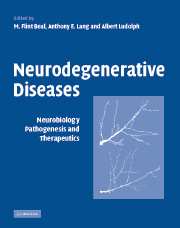Book contents
- Frontmatter
- Contents
- List of contributors
- Preface
- Part I Basic aspects of neurodegeneration
- Part II Neuroimaging in neurodegeneration
- Part III Therapeutic approaches in neurodegeneration
- Normal aging
- Part IV Alzheimer's disease
- Part VI Other Dementias
- Part VII Parkinson's and related movement disorders
- 37 Approach to the patient presenting with parkinsonism
- 38 Parkinson's disease
- 39 Neuropathology of Parkinson's disease
- 40 Genetics of parkinsonism
- 41 Pathophysiology: biochemistry of Parkinson's disease
- 42 Current and potential treatments of Parkinson's disease
- 43 Multiple system atrophy
- 44 Progressive supranuclear palsy
- 45 Corticobasal degeneration
- Part VIII Cerebellar degenerations
- Part IX Motor neuron diseases
- Part X Other neurodegenerative diseases
- Index
- References
39 - Neuropathology of Parkinson's disease
from Part VII - Parkinson's and related movement disorders
Published online by Cambridge University Press: 04 August 2010
- Frontmatter
- Contents
- List of contributors
- Preface
- Part I Basic aspects of neurodegeneration
- Part II Neuroimaging in neurodegeneration
- Part III Therapeutic approaches in neurodegeneration
- Normal aging
- Part IV Alzheimer's disease
- Part VI Other Dementias
- Part VII Parkinson's and related movement disorders
- 37 Approach to the patient presenting with parkinsonism
- 38 Parkinson's disease
- 39 Neuropathology of Parkinson's disease
- 40 Genetics of parkinsonism
- 41 Pathophysiology: biochemistry of Parkinson's disease
- 42 Current and potential treatments of Parkinson's disease
- 43 Multiple system atrophy
- 44 Progressive supranuclear palsy
- 45 Corticobasal degeneration
- Part VIII Cerebellar degenerations
- Part IX Motor neuron diseases
- Part X Other neurodegenerative diseases
- Index
- References
Summary
Introduction
The clinical features of Parkinson's disease (PD) are bradykinesia, rigidity, tremor and postural instability, but increasingly recognized are non-motor manifestations, such as anosmia, autonomic dysfunction, sleep disorders, psychiatric symptoms (e.g. depression) and cognitive impairment. The typical clinical features of PD reflect well-known pathology in the dopaminergic nigrostriatal system, while extra-nigral pathology accounts for many of the non-motor features of PD. As will be subsequently discussed, the most characteristic pathologic feature of PD is neurodegeneration with Lewy body (LB) formation, but it must be acknowledged that occasionally other pathologic processes cause clinical features typical of PD. In particular, some cases of multiple system atrophy (MSA) or even progressive supranuclear palsy (PSP) may be clinically mistaken for PD (Bower et al., 2002). More problematic are cases of PD with juvenile onset or those associated with an autosomal recessive pattern of inheritance, such as cases with Parkin and DJ-1 mutations (see below), in which LBs may not be present. Other early onset familial cases present with atypical clinical features such as early dementia and psychosis, which are not characteristic of typical PD (Gwinn-Hardy et al. 2000). Another diagnostic challenge is the relationship of cognitive dysfunction in PD to concurrent Alzheimer's disease and dementia with Lewy bodies (DLB) (McKeith et al. 1996).
As in all neurologic syndromes, the clinical presentation reflects the neuroanatomy of the disease process more than the nature of the underlying pathology.
- Type
- Chapter
- Information
- Neurodegenerative DiseasesNeurobiology, Pathogenesis and Therapeutics, pp. 575 - 585Publisher: Cambridge University PressPrint publication year: 2005

